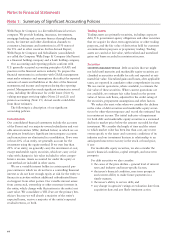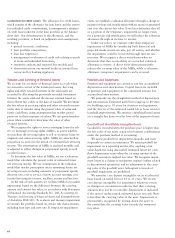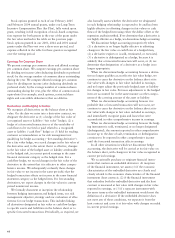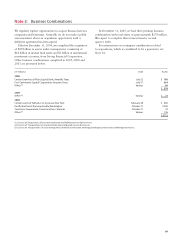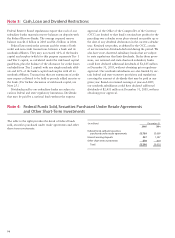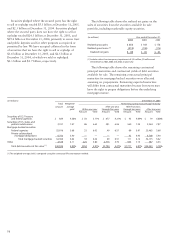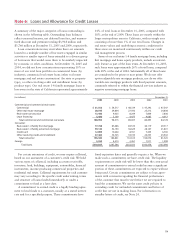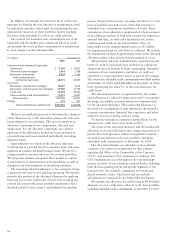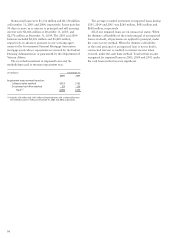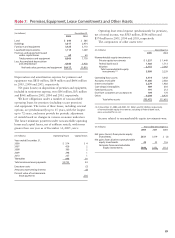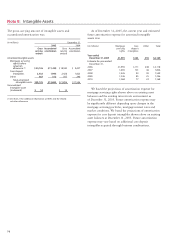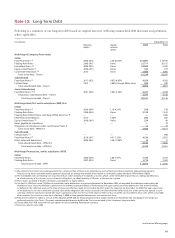Wells Fargo 2005 Annual Report Download - page 76
Download and view the complete annual report
Please find page 76 of the 2005 Wells Fargo annual report below. You can navigate through the pages in the report by either clicking on the pages listed below, or by using the keyword search tool below to find specific information within the annual report.
74
(in millions) December 31,
2005 2004
Commercial and commercial real estate:
Commercial $ 71,548 $ 59,603
Other real estate mortgage 2,398 2,788
Real estate construction 9,369 7,164
Total commercial and
commercial real estate 83,315 69,555
Consumer:
Real estate 1-4 family first mortgage 10,229 9,009
Real estate 1-4 family junior lien mortgage 37,909 31,396
Credit card 45,270 38,200
Other revolving credit and installment 13,957 15,427
Total consumer 107,365 94,032
Foreign 675 407
Total unfunded loan commitments $191,355 $163,994
In addition, we manage the potential risk in credit com-
mitments by limiting the total amount of arrangements, both
by individual customer and in total, by monitoring the size
and maturity structure of these portfolios and by applying
the same credit standards for all of our credit activities.
The total of our unfunded loan commitments, net of all
funds lent and all standby and commercial letters of credit
issued under the terms of these commitments, is summarized
by loan category in the following table:
We have an established process to determine the adequacy
of the allowance for credit losses that assesses the risks and
losses inherent in our portfolio. This process supports an
allowance consisting of two components, allocated and
unallocated. For the allocated component, we combine
estimates of the allowances needed for loans analyzed on
a pooled basis and loans analyzed individually (including
impaired loans).
Approximately two-thirds of the allocated allowance
is determined at a pooled level for consumer loans and some
segments of commercial small business loans. We use fore-
casting models to measure inherent loss in these portfolios.
We frequently validate and update these models to capture
recent behavioral characteristics of the portfolios, as well as
changes in our loss mitigation or marketing strategies.
The remaining allocated allowance is for commercial loans,
commercial real estate loans and lease financing. We initially
estimate this portion of the allocated allowance by applying
historical loss factors statistically derived from tracking loss
content associated with actual portfolio movements over a
specified period of time, using a standardized loan grading
process. Based on this process, we assign loss factors to each
pool of graded loans and a loan equivalent amount for
unfunded loan commitments and letters of credit. These
estimates are then adjusted or supplemented where necessary
from additional analysis of long term average loss experience,
external loss data, or other risks identified from current
conditions and trends in selected portfolios. Also, we
individually review nonperforming loans over $3 million
for impairment based on cash flows or collateral. We include
the impairment on these nonperforming loans in the allocated
allowance unless it has already been recognized as a loss.
The potential risk from unfunded loan commitments and
letters of credit for wholesale loan portfolios is considered
along with the loss analysis of loans outstanding. Unfunded
commercial loan commitments and letters of credit are
converted to a loan equivalent factor as part of the analysis.
The reserve for unfunded credit commitments was $186 million
at December 31, 2005, and $188 million at December 31, 2004,
both representing less than 5% of the total allowance for
credit losses.
The allocated allowance is supplemented by the unallo-
cated allowance to adjust for imprecision and to incorporate
the range of probable outcomes inherent in estimates used
for the allocated allowance. The unallocated allowance is
the result of our judgment of risks inherent in the portfolio,
economic uncertainties, historical loss experience and other
subjective factors, including industry trends.
No material changes in estimation methodology for the
allowance for credit losses were made in 2005.
The ratios of the allocated allowance and the unallocated
allowance to the total allowance may change from period to
period. The total allowance reflects management’s estimate
of credit losses inherent in the loan portfolio, including
unfunded credit commitments, at December 31, 2005.
Like all national banks, our subsidiary national banks
continue to be subject to examination by their primary
regulator, the Office of the Comptroller of the Currency
(OCC), and some have OCC examiners in residence. The
OCC examinations occur throughout the year and target
various activities of our subsidiary national banks, including
both the loan grading system and specific segments of the
loan portfolio (for example, commercial real estate and
shared national credits). The Parent and its nonbank
subsidiaries are examined by the Federal Reserve Board.
We consider the allowance for credit losses of $4.06 billion
adequate to cover credit losses inherent in the loan portfolio,
including unfunded credit commitments, at December 31, 2005.


